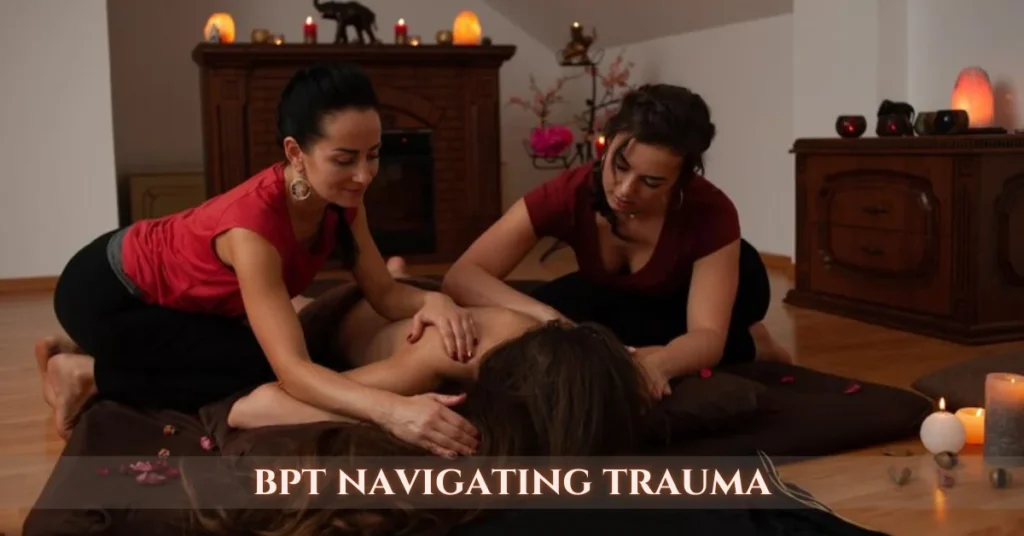Introduction to bpt navigating trauma
Trauma can cast a long shadow over our lives, affecting not just the mind but also the body in profound ways. As we navigate through these difficult experiences, many are turning to Body Psychotherapy (BPT) as a path toward healing. This approach recognizes that trauma isn’t just something we think about; it’s something we feel and carry within us physically. BPT navigating trauma offers an innovative way to address these stored emotions and physical responses, creating space for transformation and renewal.
If you’ve ever felt stuck or overwhelmed by past experiences, you’re not alone. Many people find themselves seeking solutions that go beyond traditional talk therapy. They yearn for methods that honor their whole being—mind, body, and spirit. With BPT, individuals discover how their bodies hold onto trauma—and how they can release it to reclaim their lives fully.
Let’s delve deeper into what BPT navigating trauma entails and explore its powerful potential for healing.
What is bpt navigating trauma?
BPT, or Body Psychotherapy, is an innovative approach to healing that emphasizes the connection between mind and body. When navigating trauma, it recognizes that emotional pain often manifests physically. This modality seeks to address these intertwined experiences.
In BPT navigating trauma, practitioners focus on how traumatic events shape bodily sensations and responses. By tuning into physical cues—like tension or discomfort—individuals can explore unresolved issues at a deeper level.
This process encourages awareness of how past traumas influence present behaviors and feelings. It fosters a safe space for individuals to express themselves through movement, breathwork, and other somatic techniques.
BPT offers a pathway toward recovery by bridging the gap between psychological understanding and bodily experience. It champions holistic healing as essential for those seeking solace from their pain.
Understanding Trauma and its Effects on the Body
Trauma is not just an emotional experience; it profoundly affects the body. When we encounter a traumatic event, our bodies respond instinctively. This response can lead to physical symptoms that linger long after the mind has attempted to move on.
Stress hormones flood our system during trauma, affecting everything from heart rate to muscle tension. These reactions are part of a survival mechanism but can become maladaptive if left unaddressed.
Many individuals may experience chronic pain, fatigue, or gastrointestinal issues linked to unresolved trauma. The body holds onto these experiences, often manifesting them in unexpected ways.
Understanding this connection between mind and body opens pathways for healing. Embracing both emotional and physical aspects of trauma allows for more comprehensive recovery approaches that consider the whole person rather than isolated parts of their experience.
The Role of the Body in Healing from Trauma
The body holds onto trauma in profound ways. Experiences of stress and pain can manifest physically, often leaving invisible scars. This connection between the mind and body is essential to understand.
When traumas occur, they can disrupt our natural rhythms. Tension builds up, leading to discomfort or even chronic pain. Recognizing these physical symptoms is a vital step toward healing.
Body Psychotherapy emphasizes this relationship. It encourages individuals to listen to their bodies and acknowledge sensations tied to past experiences. By doing so, we create pathways for release and recovery.
Movement becomes a powerful tool in this process. Simple exercises or breathwork can help shift stored energy, fostering emotional healing alongside physical relief.
In essence, embracing the body’s wisdom opens doors that traditional talk therapies might miss. It invites us to reconnect with ourselves in meaningful ways as we journey towards wholeness.
Techniques and Approaches Used in Body Psychotherapy
Body psychotherapy employs a range of techniques to address trauma effectively. One popular approach is somatic experiencing, which helps clients tune into their bodily sensations. This practice encourages awareness and allows for the release of pent-up emotions.
Another technique is breath work, where deep breathing exercises promote relaxation and grounding. By focusing on breath, individuals can reconnect with their bodies and ease tension.
Movement therapy also plays a significant role in BPT. Engaging in mindful movement allows clients to express feelings that may be trapped within muscular patterns.
Guided imagery offers a creative outlet for processing trauma. Clients visualize peaceful settings or supportive figures, helping them cultivate safety within themselves while confronting painful memories. Each method contributes uniquely to the healing journey by fostering self-awareness and emotional resilience.
Case Studies: Success Stories of Healing through BPT
Case studies illustrate the transformative power of BPT. One compelling example is Sarah, a young woman who faced years of anxiety stemming from early childhood trauma. Through body psychotherapy, she learned to reconnect with her physical sensations and emotions. Gradually, Sarah discovered how her body held memories that influenced her daily life.
Then there’s Mark, a veteran struggling with PTSD. For him, traditional talk therapy felt insufficient. In BPT sessions, he tapped into his body’s responses during guided movements and breathwork. This approach helped him release pent-up tension and reclaim a sense of safety in his own skin.
These stories reveal the profound healing potential within us all when we embrace our bodily experiences as part of trauma recovery. Each journey underscores the importance of listening to what our bodies have to say about pain and resilience.
Incorporating Mindfulness and Self-Care in BPT for Trauma Recovery
Mindfulness and self-care are vital components in BPT navigating trauma. They help foster a deeper connection between the mind and body, allowing individuals to process their experiences more fully.
Practicing mindfulness encourages individuals to stay present. This awareness can reduce anxiety and promote emotional regulation. Simple techniques like focused breathing or body scans can ground those healing from trauma.
Self-care routines also play a significant role in recovery. Engaging in nurturing activities—like journaling, gentle movement, or nature walks—can enhance well-being. These practices support emotional resilience by creating safe spaces for reflection.
Incorporating these elements into therapy sessions often accelerates progress. Clients learn how to listen to their bodies’ signals while developing coping strategies that empower them beyond the therapy room.
Integrating mindfulness and self-care is not just beneficial; it’s transformative on the journey toward healing from trauma through body psychotherapy.
Finding a Qualified BPT Practitioner
Finding a qualified BPT practitioner can feel daunting. Start by seeking recommendations from trusted sources. Friends, therapists, or support groups may have valuable insights.
Next, check credentials and experience. Look for practitioners who are certified in body psychotherapy and have specific training related to trauma recovery. Their educational background can make a significant difference in your healing journey.
Consider scheduling an initial consultation. This meeting gives you the chance to assess their approach and see if it resonates with you. Pay attention to how comfortable you feel during this interaction.
Trust your instincts when choosing a practitioner. The right fit is essential for effective healing as it fosters safety and connection throughout your therapeutic process.
Conclusion: Embracing a Holistic Approach to Healing from Trauma
Healing from trauma is a complex journey that requires more than just traditional talk therapy. Body Psychotherapy (BPT) offers a unique perspective by emphasizing the integral connection between mind and body. This approach recognizes that trauma doesn’t solely reside in our thoughts but often manifests physically, affecting our overall well-being.
By engaging with the body through BPT, individuals can begin to untangle the emotional and physical knots created by traumatic experiences. Techniques like breathwork, movement, and somatic awareness help clients reconnect with their bodies, fostering healing at a deeper level. The success stories emerging from this practice highlight its effectiveness for many dealing with various forms of trauma.
Incorporating mindfulness practices further enhances this healing process. By cultivating self-awareness and self-care routines alongside BPT techniques, individuals are better equipped to navigate their emotional landscapes. Finding a qualified practitioner who understands both trauma’s psychological aspects and its physiological impact is crucial for anyone seeking this path.
A holistic approach to healing not only addresses symptoms but also nurtures resilience and growth. Embracing methods like BPT can lead to profound transformation as you reclaim your life beyond past traumas. Healing is possible; it begins with understanding how deeply interconnected we are—mindfully embracing every part of ourselves on this journey toward wholeness.
ALSO READ: K Caara Leasing: Affordable Mobility for the Modern Driver
FAQs
What is “BPT Navigating Trauma”?
BPT (Body Psychotherapy) navigating trauma is a holistic approach to healing that connects the mind and body. It recognizes that emotional trauma manifests physically and uses techniques like breathwork, movement, and somatic awareness to release stored emotions and promote recovery.
How does BPT help in trauma recovery?
BPT helps release trauma stored in the body by encouraging awareness of physical sensations. Techniques like movement, breathwork, and grounding exercises allow individuals to process and express emotions tied to past traumas, promoting emotional healing.
Who can benefit from BPT navigating trauma?
Anyone struggling with unresolved trauma, anxiety, PTSD, or emotional pain can benefit from BPT. It’s particularly helpful for those looking for a mind-body approach beyond traditional talk therapy.
What are some techniques used in BPT for trauma?
BPT techniques include somatic experiencing, breathwork, mindful movement, and guided imagery. These methods help clients tune into their bodily sensations, regulate emotions, and release trapped energy linked to past trauma.
How can I find a qualified BPT practitioner?
To find a qualified BPT practitioner, seek recommendations from trusted sources, check their credentials, and consider an initial consultation. A qualified practitioner will have experience and training in body psychotherapy and trauma recovery, ensuring a safe and effective healing process.






